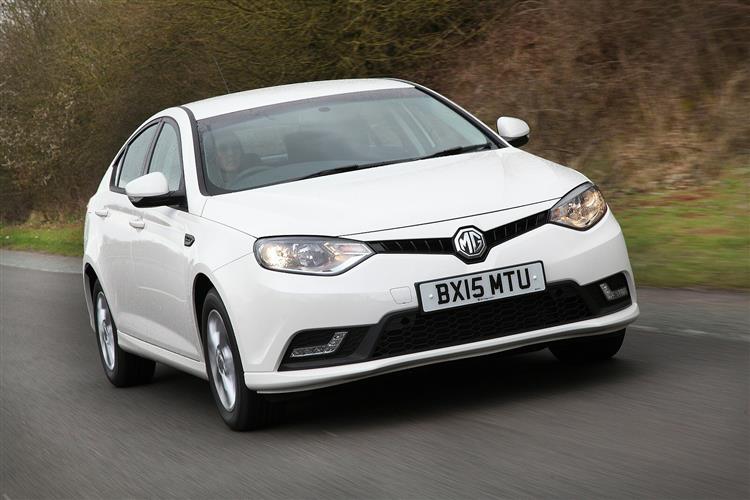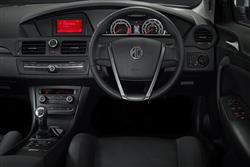CHINESE PUZZLE (some text hidden) --NONE--
BY JONATHAN CROUCH
Introductionword count: 70
The original MG6 launched back in 2011 had a number of rough edges, but the Chinese brand improved the car considerably in 2015, improving quality and technology and installing a willing 1.9-litre diesel engine. This revised design only sold in the UK for just over a year, but may be worth seeking out on the used market for family buyers looking for a Mondeo-sized model for less than Focus-sized prices.
Modelsword count: 5
5-door SUV [1.9 DTi diesel]
Historyword count: 316
The MG6. It's a car that ought to have had everything going for it. A famous badge: a super-low pricetag; a high specification: and an interior more spacious than virtually all of its rivals. It was even put together in Britain. So why was it subject an abject sales failure when new? Back in 2011, the original version of this model was the first mainstream product launched by the MG brand's new-era owners SAIC - the Chinese 'Shanghai Automotive Industrial Corporation'. The conglomerate always promised that the old MG Rover Longbridge production lines would run again and sure enough, with that original MG6, they did, even if the Birmingham workers were only bolting together kits imported from China. The car in question was actually based on a model SAIC had developed for the Chinese market and sold there badged as the 'Roewe 550', but was turned into something more MG-like thanks to the efforts of a group of ex-Rover British engineers who tweaked the chassis to suit newly-added MG branding. With decent quality and really affordable pricing, that recipe might have created a car to significantly trouble some of the smaller brands in the Focus segment. As it was, MG Motor UK found that build quality standards the Chinese market had been quite happy with were simply not acceptable to British buyers. Or at least they weren't at the kind of prices being asked. So in 2015, there was a re-think - one that brought us the much improved MG6 model we're going to look at here. Launched in the Spring of 2015, it delivered higher quality, extra technology and, most importantly, much lower pricing, all matched with super-sized standards of space and a surprisingly pokey 150PS 1.9-litre diesel powerplant. This was the car we should have had from the start but it didn't save the MG6 model line, which was quietly deleted in late 2016.
What You Getword count: 1171
By European standards, the styling of this MG6 isn't hugely arresting, but for the notoriously conservative Chinese market where it had to sell in huge numbers, it was a very dynamic-looking car indeed, a wide track and flared wheel arches enough to set Oriental hearts a-flutter. The aesthetic changes made to this improved MG6 certainly kept it up to date, though you'd need to know the original version of this car quite well to spot them. The front grille around the big MG octagon badge up-front is chrome-trimmed on the top model and was subtly restyled, as was the lower air intake that on post-2015 models was flanked by trendy LED daytime running lights. The headlights on this revised version were smarter too and on a top model, incorporated piercing Bi-Xenon beams that turn with the road. Move to the side and the profile's dominated by a sharp upper crease running alongside a lower windowline that's chrome-trimmed on most models. A subtler swage line lower down gives the flanks some shape, linking the 16-inch 'Contour' design alloy wheels that all MG6s must have. We also like the chromed side vents - who cares if they don't actually cool anything? More important though, than the look and the shape of this car is its size. At 4.65m long, it sits mid-way between a 4.4m Focus-sized 'C-segment' Family Hatchback and a 4.8m Mondeo-sized Medium Range 'D-segment' model. In other words, this car's much bigger than you'd expect it to be given its Fiesta-style entry-level price. Which is of course, something you particularly notice when it comes to boot space. Or at least the bootspace you can use once you've got your stuff inside. One of the issues with the original version of this model was the high loading lip - and the narrow boot opening on offer once you raised the steeply-raked rear hatch. Though with this revised model, this rear bumper was re-profiled for a smarter look, no real attempt was made to solve that problem, so when you raise the tailgate, there's still quite a high sill over which you've to hump your belongings. Still, once you do get everything in, the news is mostly all good. The 498-litre boot capacity is huge, beaten only in this class by the standard version of Skoda's Rapid and massively better than most of the usual choices in the family hatchback C-segment. To be specific, you're talking of a boot that's 30% bigger than a Volkswagen Golf and fully 60% bigger than that of a Ford Focus. It's also worth pointing out that a trunk of this size gives you nearly all the capacity you'd get from one of those supposedly larger 'D-segment' models we were just talking about - say something like a Vauxhall Insignia, a car with only 32-litres more of extra luggage capacity. This MG's advantage over most of its rivals continues when you push forward the 60:40 split-folding rear bench, this action freeing up a 1379-litre total. Are there issues? A few. The flattened complete cargo area isn't totally flat and the trimming in the boot does still leave a little to be desired - the carpet's still stuck down with velcro. What about the back seat, an area of the car with space you might suspect to have been compromised by all that extra boot capacity? As it turns out here, there's once again significantly more room than you'd find in a Focus or a Golf, with plenty of head, leg and shoulder room. To the point in fact, where on shorter journeys, three adults could sit together quite easily, assuming that the middle person could find some way to position themselves comfortably astride the rather prominent transmission tunnel. It was the at-the-wheel experience though, that we were keenest to sample in this car. In the original model after all, this was the area that rather let the MG6 down, with a budget brand feel to the choice of plastics used and a frustrating set of rather fiddly steering wheel controls. Fortunately, things were much improved with the post-2015 model. True, the interior still isn't quite as well finished and put together as that of a comparable Focus or Astra would be but MG certainly narrowed the quality gap to those kinds of cars. The plastic key you push into a 'Start Stop' slot on the dash still feels cheap, but not much else really does. Soft-touch plastics feature on top of the fascia, even if they're still noticeable by their absence the further down you look. And metallic inserts around the airvents and in areas like around these lower centre console ventilation controls lift the previously unremitting gloom of the sombrely-trimmed cabin. It's down here in fact that you'll notice one of this revised MG6 model's other key changes - the installation of an electronic handbrake switch. This isn't normally a feature we're particularly keen on but here, it allowed for extra storage space and a much cleaner-looking design. Perhaps the most important cabin improvement lies at the top of the dash with the provided 'MG touch' infotainment system - a standard-fit item, provided you avoid a variant fitted out with entry-level trim. With this, a bank of middle-dash switches control a 7-inch colour touchscreen mounted higher up to the left of the instrument binnacle. Included is all functionality you'd expect, so there's access to a DAB radio and the usual stereo functions, plus Bluetooth with media streaming, the option of playing video files - oh and a 'Mirrorlink' feature that allows you to replicate your mobile 'phone handset's homescreen on the display and operate that 'phone via the 'MG touch' system. The set-up also includes app-based functionality too, a good example of which is the included 'iGo Navigation by NNG' sat nav system. This includes European mapping, 3D landmarks, reality junction views, enhanced signpost information, speed limit advisories and the option of six or seven-digit postcode entry. As for the practicalities, well they're better than you might expect too. A few irritations remain, like the thick metalwork either side of the front and rear windows that can obscure your view out. The trip computer screen in the centre of the instrument binnacle is the smallest we've ever seen and the steering wheel-mounted rotary dials that operate it are fiddly to use, though the system does include a lap timer, a rather amusing touch given that this is primarily a budget-minded family car. Otherwise, though, there's not much to criticise. The big, plush seats are smartly trimmed and are also heated on all models. There's plenty of adjustability too, as there is for the big four-spoke MG-branded wheel which features leather trim and multi-function buttons on most variants and through which you view a redesigned silver-trimmed instrument binnacle complete with what the brand calls a 'tunnel-style' of gauge presentation. It's not the clearest layout we've ever seen but the red-needled dials with their silver bezels add a sporty touch that fits with the dynamic feel of this car.
To see the full road test text contact us on 0330 0020 227
Pictures (high res disabled)

.jpg)
|
.jpg)
|
.jpg)
| |||
.jpg)
|

|



